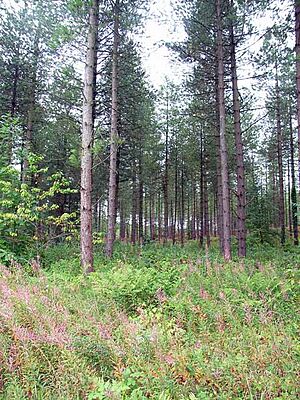Newborough Warren facts for kids
Newborough Warren (called Tywyn Niwbwrch in Welsh) is an amazing place near the village of Newborough on Anglesey, Wales. It's a huge area with sandy dunes and beautiful beaches, covering about 22.7 square kilometers. About half of this area is a forest filled with conifer trees.
This special place is protected because it's so important for nature. Most of it is a National nature reserve, which means it's looked after to protect its wildlife and habitats. The entire area is also a Site of special scientific interest, showing how valuable its plants, animals, and geology are.
Newborough Warren is bordered by two rivers, the Afon Braint to the south-east and the Afon Cefni to the north-west. It also includes parts of Llanddwyn Bay and Malltraeth Bay, which are separated by the lovely Ynys Llanddwyn island. You can even find a part of the famous Anglesey Coastal Path here, perfect for walks!
Contents
What Makes Newborough Warren Special?
Newborough Warren is a mix of different natural areas. You'll find big stretches of both moving sand dunes and older, more stable dunes. Many of these older dunes have been planted with trees, creating a unique forest.
The reserve also has a freshwater lake, salty salt marshes, and muddy areas called mudflats. There's even a tidal island, which means it's connected to the mainland at low tide but surrounded by water at high tide.
Amazing Wildlife Habitats
This area is a fantastic home for many different kinds of plants, lichens, and mosses. It's also buzzing with lots of tiny creatures called invertebrates, like insects and spiders.
The muddy areas and saltmarshes are super important for birds, especially in winter. Many waders (birds that feed in shallow water) and wildfowl (like ducks and geese) come here. For example, over one percent of all the pintail ducks in Britain spend their winters here!
Near Ynys Llanddwyn, there's a small island called Ynys yr Adar. This island is a key breeding spot for cormorants, with over one percent of Britain's breeding cormorant population nesting there.
At the very tip of Newborough Warren, you'll find Abermenai Point. This spot was likely where people first crossed the Menai Strait by ferry to the Welsh mainland a long, long time ago.
History of the Forest
People started planting trees on the moving sands of Newborough Warren in 1947. One big reason was to protect the nearby village from the shifting sand dunes. They built artificial dunes and then planted them with Corsican pine and Scots pine trees.
For a while, there were worries that the water levels in the forest and the nearby dunes were getting too low. This was partly because the trees used a lot of water. To help with this, some areas of the forest have been cleared, and other parts have had many trees thinned out.
In 2004, there were ideas to remove large parts of the forest. However, local people and some conservation groups didn't agree. Because of this, the Forestry Commission and the Countryside Council for Wales worked together to ask the public what they thought. This helped decide how the Newborough woodland would be managed in the future.
Plants of Newborough Warren
Newborough Warren is home to an amazing collection of plants. Some of them are very rare or special!
Rare and Unique Plants
You can find the Dune helleborine (Epipactis dunensis), which is a type of orchid found only in dune areas. There's also the tiny dwarf adder's tongue (Ophioglossum azoricum) and the shore dock (Rumex rupestris).
On Ynys Llanddwyn island, a very rare golden hair lichen (Teloschistes flavicans) has been discovered recently. You might also spot golden samphire (Inula crithmoides) on the island, especially on the path leading to the larger lighthouse.
Other Interesting Plants
Other cool plants to look out for include:
- Dune pansies (Viola curtisii)
- Sea spurge (Euphorbia paralias and Euphorbia portlandica)
- Sand cat's-tail (Phleum arenarium)
In the wet, low-lying areas between the dunes, called dune slacks, you can find:
- Creeping willow (Salix repens)
- Different types of orchids, like the marsh orchid (Dactylorhiza purpurella)
- Butterwort (Pinguicula vulgaris)
- Grass of parnassus (Parnassia palustris)
- Yellow bird's-nest (Monotropa hypopitys)
In recent years, the round-leaved wintergreen (Pyrola rotundifolia) has spread widely across the dune system, adding to the plant diversity.
Animals of Newborough Warren
The dunes and surrounding areas are a lively home for many animals, especially birds and insects.
Birds and Other Animals
Common birds you might see flying around or feeding in the dunes include:
- Herring gulls
- Oystercatchers
- Lapwings
- Curlews
- Skylarks
- Meadow pipits
The dunes are also home to other creatures like toads and lizards. And, of course, there are many different kinds of insects buzzing and crawling around!
Newborough Warren was even featured on the BBC TV show Autumnwatch in November 2008. The show highlighted how important ravens are to this special area.


